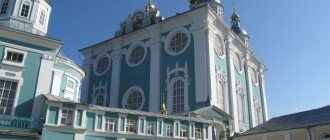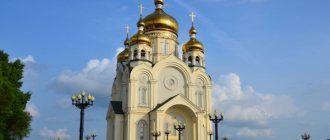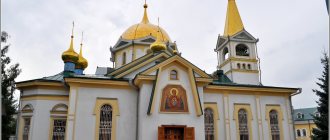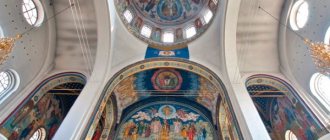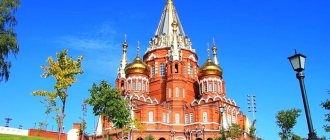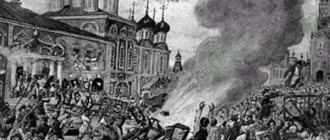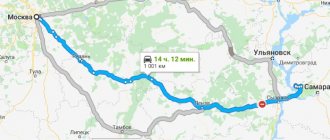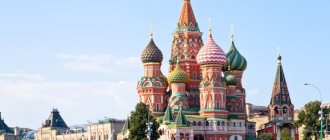The Church of St. Catherine on Vspolye is mentioned in chronicles for the first time in 1612. Presumably it was erected on the site of battles between Russian and Polish-Lithuanian troops.
However, the purpose of the church was different: they prayed to the Great Martyr Catherine with a request to facilitate childbirth and protect children.
The site for construction was chosen outside the urban settlement, on arable land, which at that time was called “underground”. The name has survived to this day.
In the chronicles of 1657, the church is listed as already made of stone. The shrine stood unchanged until 1762.
History of the temple
Catherine's Cathedral in Pushkin was built on the site of the destroyed old Tsarskoye Selo church, dedicated to St. Catherine, originally from Alexandria. At the beginning of the 30s of the XIX century. Emperor Nicholas I issued a decree on the founding of a temple in Tsarskoe Selo in honor of Catherine of Alexandria, the Christian Great Martyr. The construction of the temple was carried out with money allocated by the imperial cabinet.
The consecration of the new temple was carried out by the emperor's confessor, Protopresbyter N.V. Muzovsky in November 1840. Emperor Nicholas I and Tsarevich Alexander were present at the solemn ceremony. In subsequent years, the improvement of the temple and the temple area was constantly carried out. The landscaping of the area around the church was carried out under the guidance of master gardener F.F. Lyamin. According to his design, 12 paths leading to the temple were made.
Trees from Holland planted around the church decorated the cathedral square. The fire of 1862 that occurred in Apraksin Dvor also affected the cathedral located nearby. Particularly severe damage was caused to the bell, on which a large crack appeared from the fire. The gilding was damaged, which eventually caused rust to appear. In mid-1874, temple servants reported a cracked bell and filed a petition to replace it.
A year later, a new bell was cast, which was larger than the old one. For the dome, architect A. Vidov designed a wooden bell tower. A major renovation of the building began in the spring of 1890. There was a free parochial school at the church. After the October Revolution, the number of parishioners visiting the cathedral greatly decreased. Since the fall of 1916, the cathedral service was conducted by Archpriest of the Russian Orthodox Church John, and in October 1917 he was tragically killed.
He was remembered by parishioners as the organizer of a religious procession, calling together with other priests to stop internecine wars. The priests of the temple and parishioners insisted on the burial of Archpriest I. Kochurov in the cathedral tomb.
Over the next 10 years, processions of atheists were held around the church, trying to stop the singing of church ministers. At the beginning of the 30s. XX century The first decrees appeared on the closure of the temple. The rector of the cathedral during this period was Archpriest F. Zabelin, who was relieved of his post in 1936. A year later, the temple, surrounded by a wooden fence, began to be dismantled. The rich altar partitions were destroyed, most of the icons were burned in the basement oven.
Iconostases and church utensils were removed from the temple, and the roof of the cathedral was demolished. The remains of the building were blown up on June 10, 1939. 20 years later, a monument to V.I. Lenin was erected on the site of the cathedral, which was subsequently demolished by unknown persons in April 2004.
The restoration of the cathedral and its shrines began in 1994 and was associated with the canonization of Archpriest I. Kochurov, which took place at the Council of Bishops of the Russian Orthodox Church. During the same period, an 8-pointed cross made of wood was erected on the site of the demolished temple. Its height was 7 m. Later, the old cross was replaced with a new one, made by a monk of the Solovetsky Monastery. The temple was restored with donations from parishioners, sponsors, and residents of nearby houses.
Architect and exterior decoration of the cathedral
It was decided to revive the Catherine Cathedral in Pushkin according to archival plans. The modern temple was restored according to the design of the architect K. A. Ton, which was developed at the beginning of the 19th century, but appropriate adjustments were made. Previously, archaeological excavations were carried out, during which parts of the foundation, utilities, and church utensils were found.
Initially, one throne was installed in the temple. In the middle of the 19th century. the right (in the name of Prince A. Nevsky of Novgorod) and left (in the name of Constantine the Great and Helena Augusta) aisles were built. The one-story building had a basement, which served as a vestment store, a warehouse for candles, and a crypt for the temporary storage of the deceased.
The altar was made in the shape of a semicircle. On the snow-white walls of the cathedral, arches, bas-reliefs with images of saints and angels were made. The building was crowned with a hipped roof. There were 3 doors leading into the church; additional entrances were made to the altar and basement. In 1883 the interior was painted with white from England containing cobalt, the window frames were restored, and the images were updated.
7 furnaces were also repaired. All work was carried out with the participation of Paramon Parfentyev, an honorary citizen of the city. Above the temple towered a four-meter large bell, which was called the “Sunday bell.” It had a bas-relief depicting Empress Catherine and an ornate inscription. The iconostasis contained icons donated by Nicholas I during the construction of the chapels.
They were painted by artists of that time:
- The icons of the Holy Great Martyr Catherine, Alexandra of Rome and the Last Supper were made by a famous Russian artist of the 19th century. F. Bruni.
- The images on the doors, in front of the throne of the Resurrection of Christ, were painted by Alexei Egorov.
- The symbol of Jesus Christ and the 4 evangelists, local images, belonged to the brush of K. Bryullov.
- There are also copies of “The Crucifixion” by V. Dyck and “The Glory of the Virgin” by P. Veronese from the church of the Great Gatchina Palace, which were donated to the temple in 1850.
A. A. Kedrinsky, the chief architect of the Tsarskoye Selo Nature Reserve, worked on creating a sketch of the modern project. He proposed to restore the architectural ensemble in 2 stages. The first stone for the future foundation was laid on December 7, 2006. In subsequent years, organizational work was carried out, and on August 4, 2009, the central dome of the temple was erected on a decorative drum.
A day later, 4 small chapters were raised. For the first time after many years of inactivity, the Divine Liturgy was celebrated in the cathedral under construction. This happened on December 7, 2009. Catherine's Cathedral in Pushkin received new bells, which were installed on the belfry in 2010, but only in January 2014 were they completely covered with gold.
Church of the Great Martyr Catherine on Vspolye
In Zamoskvorechye, the role of churches as architectural dominants and landmarks of small neighborhoods is most clearly visible. Before the 1917 revolution there were fifty churches here. The classic of French literature Théophile Gautier in the middle of the 19th century traveled to Russia and was so delighted with Moscow and Zamoskvorechye in particular that he made the following entry in his diary: “It is impossible to imagine anything more beautiful, rich, luxurious, fabulous than these domes with shining gold crosses. I stood like this for a long time, in rapturous stupor, immersed in silent contemplation. To top it all off, imagine on the cold and bluish tones of the snow, as if scattered across the carpet of the Russian winter, reflections of the slightly reddish glow of the setting sun.” Returning to his homeland, he published an annotated album “Artistic Treasures of Old and Modern Russia” and published a book of essays “Travel to Russia”.
The most important historical events in our country are associated with the Church of the Great Martyr Catherine. Many books and even historical works say that the Church of the Great Martyr Catherine was built on the site where in 1612 the troops of the second people's militia of Prince D.M. Pozharsky and Kuzma Minin defeated the troops of Hetman Khotkevich. But in fact, a church already existed on this site. This is confirmed by S.M. Soloviev in “History of Russia from Ancient Times”: “Klementyevsky fort was again occupied by the Poles, and the hetman stationed his convoy near the Church of the Great Martyr Catherine (on Ordynka).”
Soloviev describes how the main stronghold of the militia, the Klimentovsky fort, passed either to the interventionists or to the liberators. Finally, when the unification of the troops of Pozharsky, Trubetskoy and the Zamoskvoretsk Cossacks took place, “the Poles could not withstand this united onslaught; having lost 500 people - a terrible loss given the small number of his troops! - the hetman left Catherine’s camp and retreated to the Sparrow Hills; the heated Russian warriors wanted to pursue the enemy, but the cautious commanders stopped them, saying that there are no two joys in one day.”
In the middle of the 16th century, in the area of today's Shchetininsky and Pogorelsky lanes, the first wife of Ivan the Terrible, Tsarina Anastasia Romanovna, built a whitewash settlement with the Church of the Great Martyr Catherine. Residents of the settlement were engaged in bleaching fabrics and yarn and were closely connected with the Kadashevskaya Sovereign Khamovna. It was not by chance that the church was consecrated in honor of this particular saint: Catherine is the patroness of pregnant women and the protector of children, and mostly women worked in the bleaching settlement. Soon the settlement began to be called Catherine's. After the Time of Troubles, it became free, and the residents of the settlement began to fulfill government orders. By 1651, there were already eighty-seven courtyards in the Ekaterininskaya Sloboda.
In 1657, on the site of the wooden one, a stone church was built with chapels of St. Nicholas the Wonderworker and Fyodor Stratilates. In 1762, after her coronation in Moscow, Catherine II wished to rebuild the temple consecrated in honor of her patron saint. The best Moscow architect K.I. took on the project. Form. Already in 1767, construction was completed. From the 1657 temple, only the refectory survived, and the Nikolsky chapel, enlarged with extensions, began to function as a “cold” church. Blank connected the winter and summer churches with the help of a two-tier bell tower, the lower tier of which became the vestibule of the summer Catherine's Church.
Although Empress Catherine II did not like baroque, the newly built church in the name of her namesake saint has baroque features. As noted in the book “Architectural Monuments of Moscow”: “Catherine’s Church is a monument of late baroque, rare for Moscow, including elements of rococo. It is obvious that Blanc has a greater connection than other Moscow masters with the St. Petersburg architecture of the 1750-1760s. The building also resembles some park pavilions of that time.” Blank introduced elements of secular architecture into church architecture. The lower tier of the church is the combined volumes of the refectory, apse and vestibule, and the upper tier is a low octagon with a heavy dome. That is, Blanc practically did not envision a vertical composition. The temple seems to be pressed to the ground under its own weight. The small elongated dome above the dome only enhances this impression. The facades of the church are decorated with columns and arches, the vestibules are rounded and highlighted by paired columns.
Catherine II donated rich utensils and a precious robe to the temple for the temple icon of the Great Martyr Catherine with the Russian coat of arms with the imperial monogram. A baroque iconostasis and silver Royal Doors with end-to-end ornaments were installed in the church, to the right and left of which there were icons depicting scenes from the life of St. Catherine. The paintings of the temple in the Italian style were carried out by the most famous artist of his time D.G. Levitsky with his students. In 1769, a fence with a lattice was built, originally made by Kremlin craftsmen for the Kremlin Cathedral Square. Some of the bars of the lattice were crowned with coat of arms eagles. It is felt that the stylistic features of the fence and the temple correspond to each other. This means that Blank followed the fate of his brainchild even after the completion of construction. Pilaster pillars with imperial crowns and massive pylons decorated with white stone eagles make the fence of the Catherine Church that has survived to this day truly unique. In the 1920s, the coats of arms of the Russian Empire, which irritated the Bolsheviks, were cut down from the bars of the grille.
During the fire of 1812, the “warm” temple burned down. In the 1820s, the architect F.M. Shestakov rebuilt parts of the church that were lost in the fire. At the same time, the temple’s fence was also completed on the side of today’s Shchetininsky Lane. The fence was precisely stylized by Shestakov to resemble Blankov’s. In 1870-1872, the “warm” church was completely remodeled by architect D.N. Chichagov. It was re-consecrated in honor of the Savior, the Image Not Made by Hands, with two chapels - Nikolsky and Alexander Nevsky. Thus, the temple began to consist of three parts standing along the same line: the Spasskaya winter church, the summer Catherine’s church and the slender bell tower, which was the compositional center of the entire structure. The unity of the composition is achieved due to the identical domes and pilasters of both churches. In the winter church, all three altars with small wooden iconostases were located in one row and connected to each other. In 1879, on the corner of Pogorelsky and Shchetininsky lanes, a brick two-story almshouse was built on the site of a wooden one from the middle of the 18th century.
In 1922, about two hundred kilograms of gold and silver were confiscated from the Catherine Church, including all the vestments and utensils donated by Catherine II. In 1931 the temple was closed. At the same time, the authorities were allowed to take only one icon - the Holy Great Martyr Catherine. She was given to the Church of the Resurrection of the Word in Monetchiki, and later to the Church of Florus and Laurus on Zatsep. In this temple, the trace of the icon is lost, and its fate is still unknown. In the 1930s, the bell tower was dismantled. The compositional completeness and expressiveness of the temple were lost because attention shifted equally to both its western and eastern parts. The heads of both churches were also damaged and the crosses on them were broken. Painting by D.G. Levitsky and his students, with the exception of certain sections, was lost.
After closing, the church housed living quarters and various organizations: the Central Design Bureau of Instrument Making, the Research Institute for Instrument Standardization. In the 1970s, restoration was carried out, as a result of which a new dome with a gilded cross was installed and the church fence was repaired. The restorers themselves (the All-Russian Art and Scientific Restoration Center named after I.E. Grabar) are located in the renovated premises. In 1992, the Catherine Church was returned to the believers, but until 1994 the All-Russian Scientific and Cultural Center remained in the building, and services had to be held on the steps of the summer church. In 1994, the temple was re-consecrated in honor of the Great Martyr Catherine by Patriarch Alexy II with the concelebration of His Beatitude Theodosius, Archbishop of Washington, Metropolitan of All America and Canada. After this, the patriarch read out a decree that the Catherine Church would become a metochion of the American Orthodox Church in Moscow.
The shrine of the temple is a large casket with particles of the holy relics of Saints Gregory the Theologian and Basil the Great, the Apostles Andrew the First-Called, Mark, Peter and Paul, the First Martyr Stephen and other saints. Particularly revered icons of the church are St. Prince Alexander Nevsky, Great Martyr Catherine, St. Tikhon with particles of their relics. Patriarch Tikhon, who was canonized as a saint in 1989, during his lifetime served liturgy in the Catherine Church every year on the day of memory of the Great Martyr Catherine. The Church of the Great Martyr Catherine conducts active educational, educational and social activities. The church has a Sunday school for adults, an art studio, a library and a video library with extensive material in English and Russian. Gospel readings are held in the church. And Catherine’s Church is the center for the distribution of humanitarian and charitable assistance from the Orthodox Church in America to the parishes of the Russian Orthodox Church.
The place where the Church of the Great Martyr Catherine stands is truly exceptional. The temple witnessed a bloody battle, the victory of the Russian militia over the Poles and Lithuanians and the liberation of Moscow from foreign invaders. Getting inside the Catherine Church, you are amazed at the simultaneous solemnity and simplicity. An important role here is played by the special lighting of the huge space due to the tiered arrangement of windows - in the refectory, the upper quadrangle, the dome and even the small dome. The Catherine Church seems to crown Bolshaya Ordynka, and the last impression of the street is formed, among other things, thanks to this special temple.
Architectural ensemble of the cathedral
The temple was built in a pseudo-Byzantine style, in the likeness of Suzdal cathedrals. The height of the building is about 50 m. Up to 2 thousand people can be in the church at the same time. The majestic five-domed temple amazes parishioners and tourists with its beauty. On the upper arches you can see the outlines of angels. The temple entrance is made in the form of a rectangular ledge; on the opposite wall there is an elegant semicircular vault decorating the church. The cathedral domes are mounted on high drums.
The façade on the eastern side of the cathedral is decorated with a mosaic icon. It depicts the face of St. Catherine, made according to a sketch by the artist A. V. Mikhalychev. The basement of the temple is given to the museum of the Tsarskoye Selo deanery, where exhibits discovered during archaeological excavations are presented. In the central part of the museum, a large place is occupied by a model of Tsarskoe Selo as it was in the pre-revolutionary years.
Among the exhibits:
- particles of priestly vestments;
- remains of silver frames from icons;
- copies of crystal chandelier pendants;
- coins of those times.
In total, more than 700 items were found. Particular attention is drawn to the box for the Holy Gifts, a large Crucifix, which were miraculously preserved after the destruction of the church in the storerooms of the Catherine Palace in Tsarskoe Selo.
Description of the cathedral
The temple was in many ways similar to the Peterhof Peter and Paul Church. It was one-story with a deep basement, where there was a sacristy, wood and candle warehouses, and crypts for especially honorable people associated with the temple. There were three porches on three sides, and the church was plastered. All five domes of the cathedral stood on the neck of the lantern.
Other churches in honor of the Great Martyr Catherine:
- St. Catherine's Cathedral in Krasnodar
- Temple in honor of the Holy Great Martyr Catherine in Feodosia
Four pillars inside held up the dome. In our time, the temple was restored according to Ton's design. Its peculiarity was that there were carved images on the walls of the temple, among which was the Great Martyr. Catherine. Icons for the Catherine Cathedral were painted by such artists as F. A. Bruni, P. A. Bryullov and others.
Divine Liturgy at St. Catherine's Cathedral
Interior decoration
The temple interior is in a state of reconstruction, but even now the interior decoration amazes with its grandeur, abundance of light and spacious rooms. The whitewashed walls are without ornament, but the presence of the main colors of the newly erected church, gold and white, reflects all the splendor of the future decoration. There are 3 altars in the altar. The main one is dedicated to the Holy Great Martyr Catherine.
On the left is for the Hieromartyr John of Tsarskoye Selo, on the right is for the holy royal passion-bearers. Pink marble used to frame doorways goes well with primary colors. Gilded architectural details repeat its pre-revolutionary design. The altar partition is white, with gilded details, restored according to old drawings.
Catherine's Cathedral in Pushkin, interior decoration.
The images of the iconostasis are made in the Old Russian style and look great on a golden background, which fits into the overall design of the interior decoration. At the western pillars there is a shrine (cases), at the north-eastern wing - the relics of Archpriest John, at the south-eastern wing - particles of the relics of Catherine of Alexandria.
Recovery
The Bolsheviks destroyed the temple on the grounds that it did not represent any cultural value, but the residents of the city of Pushkin did not agree with this, and after the destruction of the regime of the Soviet system, consistent work began to restore the Catherine Cathedral in the city of Pushkin.
Interior decoration of the Cathedral of Catherine the Great Martyr
- In 1995, a worship cross was installed on the cathedral square, which was now a public garden.
- The Lenin monument was secretly thrown off its pedestal at night in April 2004 and completely shattered.
- In 2006, excavations began in the park in order to discover the foundation of the temple.
- The foundation stone for the new temple being restored took place on December 7, 2006. It was planned to restore the cathedral for the 300th anniversary of Tsarskoye Selo.
- In 2009, all five chapters of the cathedral were raised and the bells of the belfry were consecrated.
And on June 27, 2010, Patriarch Kirill consecrated the already completely finished Catherine Cathedral.
Shrines and relics of the temple
Before destruction, particularly important shrines included:
- The Ark with the placed finger of St. George the Victorious and part of the Life-Giving Tree, which was donated by Prince Heraclius of Georgia in memory of his deceased sister.
- Icon of Saint Panteleimon the Healer, panagia.
- A reliquary cross in memory of the deceased son of Mrs. Volkova.
- Icon of the Moscow saints from Bishop Philaret.
- A chalice, silver-gilded with images on a copper plate and rhinestones of different colors, transferred from the Ascension Cathedral in Sofia in 1812.
- Silver chalice depicting the icon of the Last Supper.
- A silver ark weighing 7 kg in the shape of a mountain with the tomb of the Savior with holy faces.
- The altar cross on the throne is silver-gilded, with images on a copper plate and rhinestones.
- Icon of the Virgin Mary of Vladimir in a silver-gilded robe.
Revered saints of the modern temple:
- Relics of the clergyman John.
- Relics of Saint Catherine of Alexandria.
- Miraculous copy of the icon of the Mother of God “Consolation in Sorrows and Sorrows” with the signature of Bishop Metropolitan Veniamin.
- List of the icon of the Mother of God "Prodromitissa of Iasi" from the Romanian Orthodox monastery of Prodromo.
Shrines[edit]
Icon of the Mother of God “Iverskaya”.
During the abbotship of Archpriest John Pashkevich, the Iveron Icon of the Mother of God was painted and consecrated for the church, which on the day of consecration showed a miracle of its mercy - the seal of grace on the face of the Mother of God in the form of flowing tears, which are still visible to all people who come to this icon.
The church has a calendar ark with the relics of Orthodox saints
for every day of the year. List of particles of holy relics, with the day of remembrance indicated next to them:
- Abundius of Cordoba (martyr) 11.06
- Abundantius (holy martyr)
- Augustine the Blessed (St.)
- Avdifax (holy martyr) 19.07
- Avdon (Persian holy martyr) 12.08
- Abraham (St. Bishop of Carria) 27.02
- Avundius (holy martyr, deacon) 26.08
- Agathon (St. Bishop of Rome) 20.02
- Agathon (holy martyr) 02.09
- Agathia of Sicily (holy martyr) 18.02
- Agnes of Rome (holy martyr) 5.07
- Alexander (St. Martyr of Alexandria) 23.04
- Alexander (Roman martyr) 26.05
- Alexander (holy martyr, warrior, martyr) 23.06
- Alexander (martyr of Egypt) 22.07
- Alexander (holy martyr, warrior) 22.07
- Alexander (martyr of Bergamo, warrior) 11.10
- Amaranth (holy martyr)
- Amator of Auxerre (holy bishop)
- Amantius (holy bishop)
- Ambrose of Milan (St.)
- Ammonius (holy martyr) 10/27
- Anacletus (holy martyr, bishop of Rome) 20.06
- Anastasius (St. Bishop of Rome)
- Anastasius the Persian (holy martyr, monk) 04.02
- Anastasius Sinait (St. Bishop of Antioch) 03.05
- Andrew the First-Called (holy apostle, martyr) 13.12
- Anicetus (holy martyr, bishop of Rome)
- Aniketas (St. Martyr of Nicomedia) 25.08
- Anna the Righteous, mother of the Mother of God (St.)
- Ansan (holy martyr, bishop of Mediolan)
- Ansovin (St. Bishop of Cameroon)
- Anthony the Great (St.)
- Antonin of Pamiers (martyr)
- Anthimus (holy Roman martyr) 20.06
- Apollinaris (martyr, bishop) 05.08
- Apollonia of Alexandria (holy martyr) 22.02
- Apronian (holy Roman martyr) 20.06
- Artemy (holy martyr) 02.11
- Aphrodisius (St. African Martyr) 06.01
- Athanasius of Alexandria (holy bishop) 31.01
- Aspren (St. Bishop) 03.08
- Benign of Todiya (holy martyr) 13.02
- Boniface (St. Martyr) 18.06
- Burckhard (St. Bishop of Würzburg)
- Valentine (St. Martyr of Viterbsk) 09.11
- Valerian (holy martyr) 28.09
- Valeria of Milan (holy martyr) 06.05
- Barbara (Holy Martyr of Nicomedia) 17.12
- Barnabas (St. Apostle from the 70th) 17.01, 24.06
- Bartholomew (St. Apostle) 07.09
- Basil the Great (saint, church teacher) 14.01, 12.02
- Vasilissa (holy martyr) 8.01
- Vass (holy martyr)
- Vassian (holy martyr)
- Venantius (St. Camerian martyr)
- Benedict of Nursia (holy venerable) 27.03
- Venust (St. African Martyr) 29.05
- Venust (holy Roman martyr)
- Viviana (holy martyr of Rome) 22.03
- Vincent (holy martyr)
- Vincent of Saragossa (holy martyr) 11.11
- Victor (holy martyr, warrior) 19.07
- Victor of Damascus (holy martyr, warrior) 11/24
- Victor (St. African Martyr) 12/18
- Victorinus (holy martyr) 31.12
- Vitus (holy martyr) 28.06
- Vitaly (holy martyr) 07.02
- Vulpian (Holy Martyr of Tyre)
- Gavinius (Roman martyr) 24.08
- Guy (holy martyr, bishop of Rome)
- Gaudencia (Holy Roman Martyr)
- Genesius (Holy Martyr of Arelat) 28.09
- Gerard of Hungary (holy martyr, bishop)
- St. Gergius the Victorious (Holy Great Martyr) 06.05
- Hyginus (holy martyr, bishop of Rome)
- Gorgonius (St. Martyr of Nicomedia) 16.09
- Gregory Dvoeslov (teacher of the Church, Bishop of Rome) 25.03
- Desiderius (holy confessor)
- Demetrius (holy martyr) 28.04
- Demetrius (holy martyr) 11/28
- Dionysius the Areopagite (holy martyr, bishop) 17.01
- Domnin (St. Martyr of Thessalonian) 14.10
- Domnion (St. Martyr of Bergamo)
- Donat (martyr) 13.05
- Dorothea (Holy Martyr) 19.02
- Eugene (holy martyr, bishop of Autun) 20.03
- Eucarpius of Nicomedia (holy martyr) 31.03
- Eusebius (holy martyr) 05.07
- Eusebius (St. Roman) 20.10
- Eustathius (St.) 11.04
- Eustathius (Holy Great Martyr) 03.10
- Eutychian (St. Martyr of Nicomedia) 30.08
- Eutyches (Holy Thracian Martyr) 06.09
- Eutyches (holy martyr) 20.11
- Catherine (St. Martyr of Alexandria) 07.12
- Eleusipius (holy martyr) 29.01
- Elizabeth the Righteous, mother of John the Baptist (St.)
- Emilian (holy martyr) 31.08
- Epiphanius of Cyprus (holy bishop) 25.05
- Hermas (holy apostle from 70, bishop) 13.06
- Ephraim the Syrian (Holy Deacon)
- Helena Empress (St.) 03.06
- Zechariah the Righteous, father of John the Baptist (St.)
- Zechariah (Holy Martyr of Nicomedia) 10.06
- Zeno (Roman holy martyr) 20.05
- Jacob Alfeev (Holy Apostle)
- James Zebedee (Holy Apostle) 13.05
- Iannuarius (holy martyr, bishop of Benevento) 04.05
- Jerome of Stridon (saint, church teacher)
- Hilary (holy martyr) 12.07
- Hilary of Pictavia (holy bishop) 12.01
- Innocent of Sirmium (holy martyr) 19.07
- Innocent (holy martyr, warrior) 05.10
- Innocent I (St. Bishop of Rome)
- Joachim the Righteous, father of the Mother of God (St.)
- John the Baptist (holy prophet)
- Irenaeus (Roman martyr) 26.08
- Irinius of Lyons (holy martyr, bishop of Lugdun) 18.06
- Jude (holy apostle, martyr) 02.07
- Julian (martyr) 3.01
- Julian (holy martyr) 29.03
- Julian (martyr of Egypt) 04.07
- Julian of Carthage (holy martyr) 19.02
- Justin (Holy Roman Martyr) 11.06
- Justin (holy martyr) 15.10
- Justina (Holy Martyr of Nicomedia) 15.10
- Julian of Cagliari (martyr)
- Calixtus I (holy martyr, bishop of Rome)
- Candide (Roman martyr)
- Candide (St. African Martyr) 03.02
- Cantidius (Egyptian martyr) 18.08
- Cassian (Roman holy martyr)
- Cassian (St.) 12.03
- Cast (holy martyr) 14.10
- Caesarea (St. Martyr of Damascus) 11/14
- Quinct of Phrygia (St. Confessor of Lucania) 19.07
- Quinctian (Saint African Martyr)
- Quintin (holy martyr)
- Cilicia (Holy Roman Martyr) 05.12
- Cyprian (holy martyr, bishop of Carthage) 13.09
- Cyriacus (St. Roman Martyr) 07.06
- Cyril (holy martyr) 18.03
- Claudius of Corinth (St.)
- Claudius (Roman martyr) 31.12
- Clement (holy apostle, martyr, bishop of Ancyra and Galatia) 17.01, 22.04, 10.09
- Clement I (holy martyr, bishop of Rome) 08.12
- Columbus (St. Apostle of Scotland) 22.06
- Constantine (St. Martyr of Carthage) 11.03
- Cornelius (St. African Martyr) 26.09
- Cosmas and Damian (holy martyrs of Arabia) 30.10
- Chriskent (holy martyr, bishop) 03.07
- Christentinian (holy martyr) 20.06
- Lawrence (holy martyr) 23.05
- Lazarus of Bethany, friend of the Lord (St.) 10/30
- Lawrence (Roman martyr) 23.08
- Largus (Roman holy martyr)
- Leo (St., Bishop of Rome) 03.03
- Leo of Katansky (holy bishop) 05.03
- Leo III (St., Bishop of Rome)
- Leontius (Holy Martyr of Nicomedia) 07.05
- Leonty (Holy Martyr of Alexandria) 26.09
- Leah (St. widow of Rome)
- Luke (holy apostle, evangelist) 31.10
- Lucian (St. African Martyr) 03.03
- Lucian (holy martyr) 20.07
- Lucian (holy martyr) 28.10
- Lucius (holy martyr) 20.07
- Lucius (St. Roman Martyr) 27.08
- Lucius (Holy Martyr of Cyprus) 02.09
- Lucia (Holy Martyr of Syracuse) 26.12
- Lucretia (St. Martyr of Cordoba)
- Magnus (Roman martyr) 04.02
- Magnus of Orkney (Roman holy martyr)
- Macarius of Egypt (St. Venerable) 19.01
- Macarius (St. Martyr of Alexandria) 01.02
- Macarius (St. Bishop of Antioch) 09.04
- Macarius (St. Martyr of Alexandria) 19.09
- Macrovius (holy martyr) 26.09
- Maxim (holy martyr) 13.05
- Mansvet (St. Martyr of Alexandria)
- Margaret (Holy Martyr of Antioch) 30.07
- Mary Magdalene (St.) 04.08
- Mark (holy evangelist, martyr, bishop) 17.01
- Marcellus (Roman martyr) 12.11
- Marcellinus (holy martyr)
- Markellinus (St. Roman Martyr) 20.06
- Marcian (St. Egyptian Martyr) 18.06
- Martin (St. Bishop of Tours) 25.10
- Martinian (holy martyr) 23.10
- Marcellus (holy martyr, bishop of Rome) 7.06
- Matthew (holy apostle, evangelist, martyr) 9.08, 13.07
- Mercury (holy martyr of Caesarea Cappadocia) 10/24
- Modest of Trier (St. Bishop) 31.12
- Mokiy (Holy Martyr of Constantinople)24.05
- Monica (St., mother of Blessed Augustine) 17.05
- Mucian (holy martyr)
- Innocent babies of Bethlehem (holy martyrs) 11.01
- Nemesius (St. Martyr of Alexandria) 15.08
- Neophyte (Holy Martyr of Antioch) 03.02
- Nestor of Perga (holy martyr, bishop of Magiddia) 13.03
- Nestor (holy martyr of Gaz) 04.10
- Nicasius (holy martyr, bishop of Reims) 22.06
- Nicholas of Myra the Wonderworker (St.) 19.12
- Olympius (Roman martyr) 12.08
- Optat (St. Martyr of Zaragoza)
- Paul (holy apostle, martyr) 12.07
- Paul (St. Bishop of Constantinople) 11/19
- Pavel of Thebes (holy venerable) 28.01
- Peacock (St., Bishop of Nolan) 05.02
- Panteleimon the Healer (Holy Martyr) 09.08
- Paternian (holy martyr, monk)
- Paphnutius (Egyptian holy martyr) 08.10
- Perpetua (St. Martyr of Carthage) 14.02
- Peter (saint, apostle, martyr) 13.07, 12.07, 29.01
- Peter (holy martyr) 17.10
- Pius I (martyr, pope)
- Pist (St. Martyr Fidel)
- Placidus (holy martyr) 10/18
- Polycarp of Smyrna (holy bishop) 8.03
- Pontianus of Spoleto (holy martyr) 19.01
- Pontian (holy martyr, bishop of Rome) 18.08
- Potitus of Sardinia (martyr)
- Praxeda (Holy Roman Martyr) 21.07
- Prim (Holy Martyr of Antioch) 14.10
- Priscian (St. Roman Martyr)
- Process (Holy Roman Martyr) 24.04
- Prot (Roman martyr) 06.01
- Radegund (St.)
- Radegunda, Queen of Pictavia (St.)
- Remigius of Reims (saint, bishop) 13.01
- Restitution (Holy Roman Martyr)
- Richard (holy king of angels) 07.02
- Robustian (holy martyr)
- Robustian (St. Martyr of Mediolan)
- Rogat (St. African Martyr) 12.01
- Roman (holy Roman martyr, warrior) 23.08
- Roman (St. Martyr of Antioch) 10.12
- Rufus (holy martyr) 04.07
- Rufus (holy martyr) 11/23
- Rufinus (Saint African Martyr) 23.03
- Rufinus (holy Roman martyr) 20.04
- Savva the Sanctified (saint, monk) 12/18
- Saturninus (Roman martyr) 20.06
- Saturninus of Cagliari (martyr)
- Sebastian of Rome (holy martyr) 12/18
- Severin (St. Bishop of Septempede) 17.06
- Septiminus (holy martyr) 12.09
- Servulus (St. Martyr of Andrumet) 27.05
- Seconds (holy martyr) 10.01
- Seconds (holy martyr) 14.02
- Secundinus of Corduba (holy martyr)
- Silverius (holy martyr, bishop of Rome)
- Sylvester I (holy martyr, bishop of Rome) 15.01
- Simeon the Youth (Holy Martyr of Tridentine)
- Simplicius (St., Bishop of Rome)
- Sisinius (Holy Roman Martyr) 20.06
- Sozont (St. Martyr of Pompeoli) 20.09
- Soterida (holy Roman martyr) 10.02
- Stactaeus (Roman holy martyr)
- Stephen (Holy Martyr of Jerusalem) 09.01
- Stephen I (holy martyr, bishop of Rome) 15.08
- Tarsitius (Roman holy martyr)
- Telesphorus (holy martyr, bishop of Rome) 22.02
- Timothy (martyr) 01.09
- Torquatus (holy martyr, bishop)
- Torpesius of Pisa (martyr)
- Tranquillinus (Roman martyr) 31.12
- Ursinius (St. Bishop of Boer)
- Ursmar (St. Bishop) 19.04
- Ursula (Holy Martyr of Cologne) 03.11
- Fabian (holy martyr, bishop of Rome) 5.08
- Thekla (Holy Martyr of Iconium) 07.10
- Felix (African holy martyr) 12.07
- Felix (holy martyr, bishop of Rome) 07.02
- Felix II (martyr, pope)
- Felix (holy martyr) 04.09
- Felix (Holy Martyr of Tunisia) 01.11
- Felician (holy martyr) 9.06
- Theodore (St. Martyr of Antioch) 06.12
- Theodora (martyr) 9.06
- Theodulus (holy martyr of Crete) 05.01
- Theodulus (Holy Martyr of Thessalonian) 18.04
- Theophan (St. Bishop of Constantinople) 10/24
- Festus (St. Martyr of Tuscany)
- Philip (St. Apostle)
- Firmin (holy martyr, warrior) 07.07
- Flavian (holy martyr)
- Phocas of Sinope (holy martyr of Antioch, bishop) 5.10
- Thomas (holy apostle, bishop, martyr) 11/14
- Fortunatus (martyr) 12.09
- Fortunian of Salerno (holy martyr) 12.09
- Photinia Samaritan (holy martyr) 02.04
- A piece of scarlet in which the Roman wars dressed Christ when they mocked Him
- Part of the nativity scene (Caves of the Nativity of the Savior)
- A piece of rope (the Bond of Christ), which tied the Savior’s hands to the pillar during the scourging
- Piece of the Holy Sepulcher
- Particle of stone from Golgotha
- Flagellation Column Particle
- Piece of Joseph the Betrothed's clothing
- Piece of John the Evangelist's clothing
- Piece of the Robe of the Virgin Mary
- Piece of the Last Supper Table
- Particle of the Tablet with the inscription of the guilt of Christ attached to the Life-Giving Cross
- Aegidius of Narbonne (St.) 01.09
- Elesbaan (St., King of Ethiopia)
- Emigdius (holy martyr, bishop) 05.08
- Emilius (Saint Martyr of Sardinia)
- Emund (St. Martyr, King of England) 03.12
- Erminingeld (holy martyr) 14.11
- Juvenal (St. Martyr of Benevento) 15.07
- Juventius (St. Roman Martyr) 01.06
- Julian of Le Mans (holy bishop) 27.01
- Julius (British holy martyr) 01.07
- Julius (St. Bishop of Rome)
- Jacob of Palestine (holy hermit) 11/26
- Yakundius (holy martyr)
Mentors
The names of all the abbots of the cathedral have been preserved in the history of the temple:
| Years of Service | Names |
| 1841-1865 | Priest Theodore Tigodsky |
| 1865-1883 | Senior priest Andrei Vetvenitsky, teacher of the law at the Imperial Gymnasium in Tsarskoe Selo |
| 1883-1893 | Priest Pavel Lamanov |
| 1893-1916 | Senior Priest Afanasy Belyaev, confessor of Nicholas II |
| 1916-1935 | Senior Priest Nikolai Smirnov |
| 1935-1938 | Senior Priest Theodore Zabelin |
From 2009 to the present, senior priest Nikita Zverev has served as rector of the cathedral.
Modern temple servants:
- Archpriest S. Yu. Kalinin.
- Priest V. M. Melkonyan.
- Priest F. Iliovsky.
- Protodeacon V.I. Kryukov.
- Deacon of the cathedral I. A. Arzeikin.
Visiting rules
To get acquainted with the architecture and interior decoration of the church before visiting, you need to check the time. In the cathedral, it is customary to turn off the sound of your mobile device. Men must remove their hats, and women, on the contrary, must enter with their heads covered. Clothing should hide the shoulders and décolleté. It is unacceptable to visit the temple in see-through or open clothing.
You cannot take photographs without the prior consent of the clergy during the service. It is strictly forbidden to carry bladed weapons, piercing and cutting objects, flammable and toxic substances, or visit the cathedral while intoxicated. It is not permissible to take animals with you or enter with food. It is prohibited to touch exhibits, go beyond fences, cause damage, or leave trash in the room.
Patronal holidays
In Pushkin, parishioners of the Catherine Cathedral venerate the saints in whose honor the temple was consecrated and celebrate their patronal feast days:
| date | Patronal festivities |
| February 7 | The main altar was consecrated in honor of St. Catherine of Alexandria |
| July 17th | 2 chapels were consecrated in honor of the holy royal passion-bearers Nicholas II and his family |
| July 11 | Moving feast of the Synaxis of St. Petersburg Saints |
| December 1 | Cathedral of Saints of the Estonian Land |
| October 31 | Repose in the name of the Hieromartyr John |
The main shrine of the temple is the holy relics of the Hieromartyr John, who was shot in 1917 for his faith.
Catherine's Cathedral in Pushkin has 3 ascribed churches:
- Temple chapel of the blessed prince Igor of Kyiv, Chernigov in Tsarskoe Selo.
- Church of the Icon of the Mother of God, located in the city of Pushkino.
- The current Znamenskaya Church.
- The restored church in the Catherine Palace.
Current state[edit]
In March 1996, part of the building of the Church of the Holy Great Martyr Catherine was returned to the St. Petersburg Diocese and on November 21 of the same year the first Divine Liturgy took place here. From that time on, regular services began, so far only in the room under the bell tower, since the main part of the temple needs complete restoration.
The church operates catechist courses, a bookstore, an amateur choir, and a service for helping sick children at a children's hospital.
The first steps have been taken to restore the temple. On December 1, 2000, on the eve of the Temple Festival, a joyful and long-awaited event took place - the erection of a gilded cross on the bell tower. And on December 7, 2004, for the first time in many decades after the closure of the church, a prayer service was served to the Holy Great Martyr Catherine in the liberated part of the church under the dome. Preparatory work has been carried out for the complete restoration of the sculpture of an Angel with a cross on the dome of the temple. We hope that soon the Church of the Holy Great Martyr Catherine will regain its former splendor and become another spiritual and educational center of the city on the Neva.
Interesting facts about the cathedral
Catherine's Cathedral in Pushkin was recreated in the image of a destroyed church that stood on this site a century ago.
The cathedral has 3 altars:
- The main one serves for holding liturgies in the name of St. Catherine of Alexandria.
- The right one is in the name of the holy royal passion-bearers, canonized by the Russian Orthodox Church.
- Left - in the name of the Hieromartyr John of Tsarskoye Selo, Priest Kochurov I.A.
In the fall of 1912, Father Jacob Chervyakovsky baptized the famous Russian scientist and writer Lev Gumilyov in the cathedral.
Since June 2014, the basement of the temple has been turned into a museum of the Tsarskoye Selo deanery. The exhibits include objects found during excavations, portraits of temple servants, various models, materials from the Tsarskoye Selo Museum, and interactive screens with additional information.
Information for visitors
Conversations about the sacraments of baptism and weddings are held daily at 16:30. Before the start of the liturgy, half an hour is set aside for the sacrament of confession. Official website of Catherine's Cathedral: soborekaterina-ru. Catherine's Cathedral group on the VKontakte website: club24445808.
Phone numbers you can call to coordinate excursions:
- +7;
- +7.
Tourists visiting Catherine Park cannot pass by the Cathedral in Pushkin. This unique architectural object is closely associated with many historical names and events, which can be learned about within the walls of the museum, located in the lower floors of the church.

